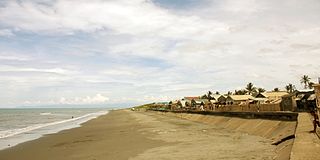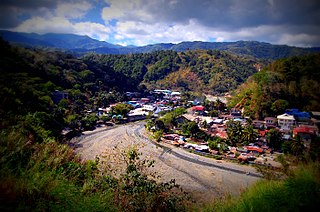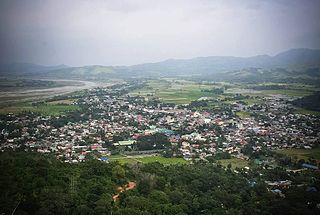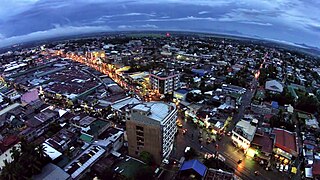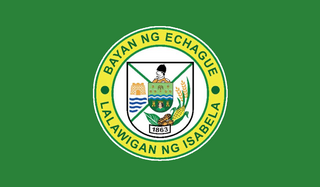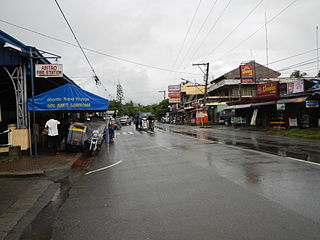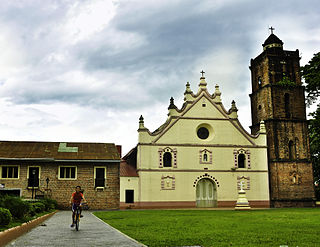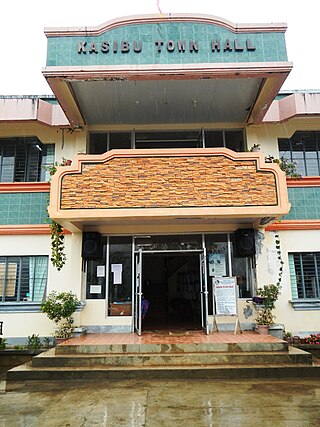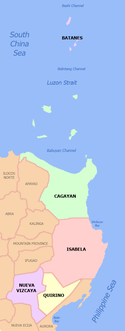This article needs additional citations for verification .(January 2012) |
Bayombong | |
|---|---|
| Municipality of Bayombong | |
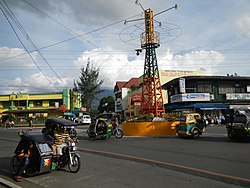 Downtown area | |
 Map of Nueva Vizcaya with Bayombong highlighted | |
Location within the Philippines | |
| Coordinates: 16°29′N121°09′E / 16.48°N 121.15°E | |
| Country | Philippines |
| Region | Cagayan Valley |
| Province | Nueva Vizcaya |
| District | Lone district |
| Founded | 12 June 1739 |
| Barangays | 25 (see Barangays) |
| Government | |
| • Type | Sangguniang Bayan |
| • Mayor | Antonio Sergio G. Bagasao |
| • Vice Mayor | Ramon T. Cabauatan |
| • Representative | Luisa L. Cuaresma (Lakas-CMD) |
| • Municipal Council | Members |
| • Electorate | 38,252 voters (2022) |
| Area | |
| • Total | 163.36 km2 (63.07 sq mi) |
| Elevation | 342 m (1,122 ft) |
| Highest elevation | 770 m (2,530 ft) |
| Lowest elevation | 254 m (833 ft) |
| Population (2020 census) [4] | |
| • Total | 67,714 |
| • Density | 410/km2 (1,100/sq mi) |
| • Households | 18,012 |
| Economy | |
| • Income class | 1st municipal income class |
| • Poverty incidence | 6.82 |
| • Revenue | ₱ 231.7 million (2020) |
| • Assets | ₱ 383.9 million (2020) |
| • Expenditure | ₱ 207.4 million (2020) |
| • Liabilities | ₱ 108.9 million (2020) |
| Service provider | |
| • Electricity | Nueva Vizcaya Electric Cooperative (NUVELCO) |
| Time zone | UTC+8 (PST) |
| ZIP code | 3700 |
| PSGC | |
| IDD : area code | +63 (0)78 |
| Native languages | Gaddang Ilocano Tagalog |
| Website | nuevavizcaya |
Bayombong, officially the Municipality of Bayombong (Gaddang : Ili na Bayombong; Ilocano : Ili ti Bayombong; Tagalog : Bayan ng Bayombong), is a 1st class municipality and capital of the province of Nueva Vizcaya, Philippines. According to the 2020 census, it has a population of 67,714 people. [4]
Contents
- Etymology
- History
- Early history
- Spanish era
- American era
- Japanese era
- Philippine independence
- Cityhood proposals
- Geography
- Barangays
- Climate
- Demographics
- Language
- Economy
- Tourism
- Government
- Local government
- Elected officials
- Education
- Colleges and universities
- Technical schools
- High schools and senior high schools
- Elementary schools
- Private preschools
- Playhouse and tutorial services
- Notable personalities
- Sister cities
- Media
- AM
- FM
- Television
- References
- External links
Bayombong is the seat of the Provincial Capitol of Nueva Vizcaya. The name Bayombong emanated from the Gaddang word “Bayongyong” which means the confluence of two or more rivers. It has been reported that a certain tribe arrived and tried to invade the place, which caused the outbreak of the first tribal war in the area. The site was renamed “Bayumbung” as a sign of the Gaddangs' first victory in fighting for their private domains.







